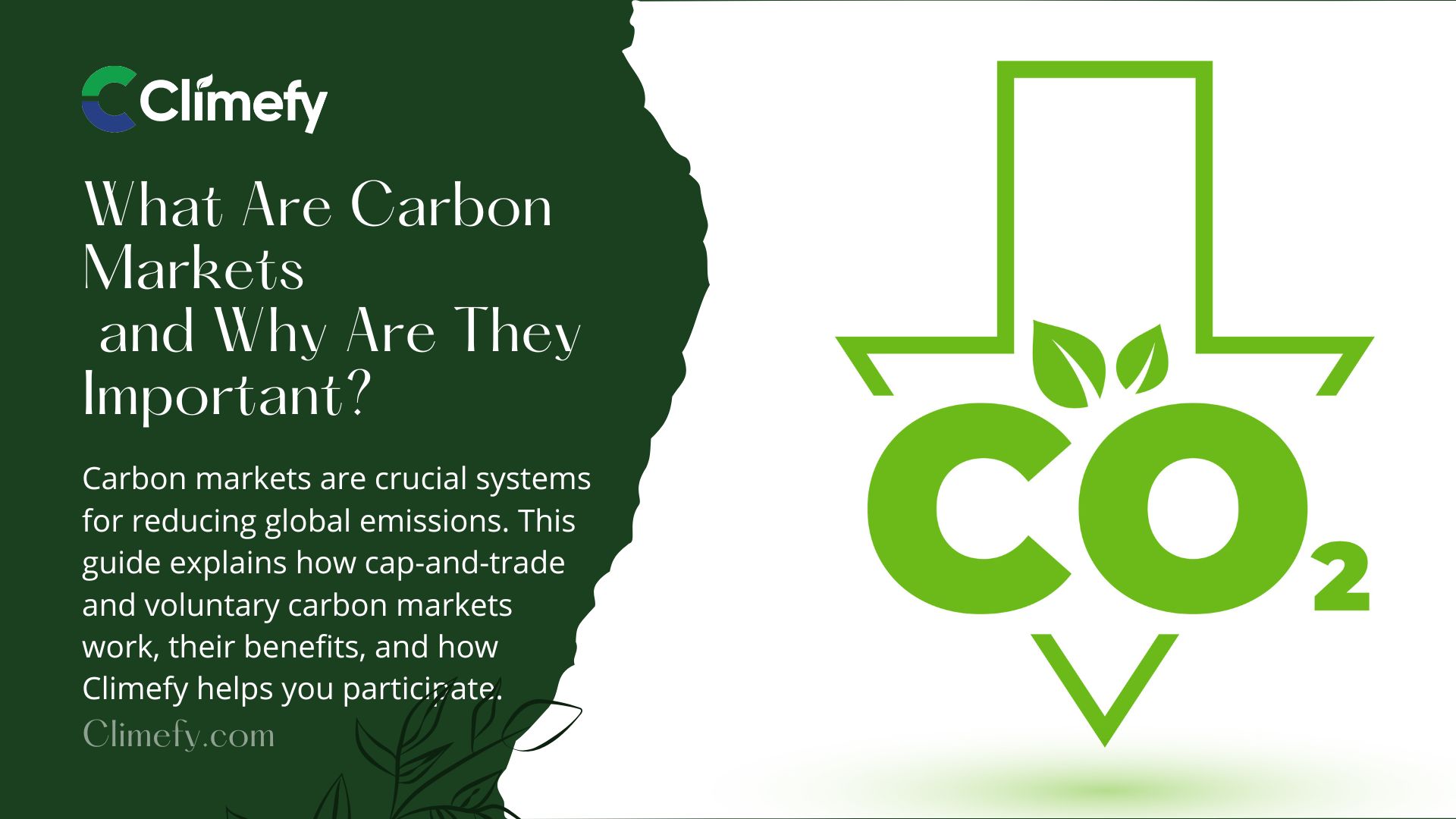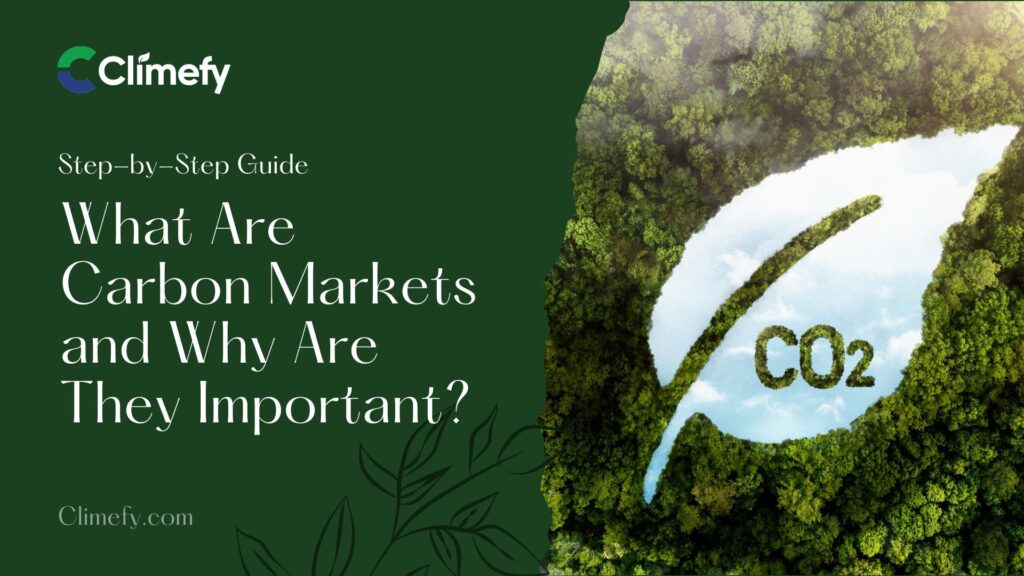

Carbon markets are innovative trading systems that provide a economic solution to the complex problem of climate change by putting a price on carbon emissions. These markets are a cornerstone of global climate policy, creating a financial incentive for companies and nations to reduce their greenhouse gas emissions and invest in cleaner technologies.
In this comprehensive guide, you will learn:
Read More:

Carbon markets, often referred to as emissions trading systems (ETS), are platforms where carbon credits (or carbon allowances) can be bought and sold. One tradable carbon credit is typically equal to one tonne of carbon dioxide (CO2) or the equivalent amount of other greenhouse gases (GHGs) like methane or nitrous oxide.
The foundational principle is to create a “cap” on total emissions or to finance projects that reduce emissions elsewhere, thereby harnessing the power of market forces to find the most cost-effective paths to decarbonization.
This market-based approach internalizes the external cost of carbon pollution, meaning emitters must pay for their environmental impact, which was previously considered a “free” byproduct of industrial activity.
The ultimate goal of these environmental markets is to drive investment towards green technologies and sustainable practices, making it more financially attractive to reduce emissions than to continue polluting.
The core concept was pioneered as a key policy instrument for pollution control and has been successfully applied to other pollutants, such as sulfur dioxide, before being adapted for the monumental challenge of climate change.
The architecture of a carbon market is designed to achieve a specific environmental outcome—a reduction in the concentration of GHGs in the atmosphere—with flexibility, encouraging emission cuts where they are cheapest to implement.
This is crucial for achieving the ambitious goals set out in international agreements like the Paris Agreement, which aims to limit global warming to well below 2 degrees Celsius above pre-industrial levels.
Key components that form the backbone of any carbon market include:
✔ A Cap or Baseline: A limit set on the total amount of GHGs that can be emitted by the entities covered by the system.
✔ Carbon Credits/Allowances: The permits or certificates that represent the right to emit a specific amount of CO2e.
✔ Carbon Offsets: Certificates representing reductions or removals of GHGs from a project outside of the capped system.
✔ Trading Platform: A marketplace where buyers and sellers can transact these credits and offsets.
✔ Monitoring, Reporting, and Verification (MRV): Robust systems to track emissions and emission reductions accurately and ensure they are real and verifiable.
✔ Regulatory Oversight: A governing body that sets the rules, manages the cap, and ensures compliance.
Understanding your own carbon footprint is the first step towards engaging with these markets. For businesses of all sizes, using a reliable carbon calculator for companies is essential to measure baseline emissions. Platforms like Climefy provide advanced tools for this purpose, helping organizations from small businesses to large corporations accurately assess their emissions across all scopes.
The functionality of carbon markets can be broken down into two primary, interconnected mechanisms: cap-and-trade systems and carbon offsetting. A cap-and-trade system is a regulatory market where a government or international body sets a mandatory cap, or limit, on the total greenhouse gas emissions permitted from a specific group of entities, such as power plants, industrial facilities, or the aviation sector.
This cap is reduced over time, driving down total emissions. Within this cap, companies receive or buy emission allowances, which they can trade with one another. If a company emits less than its allowance, it can sell its surplus credits to another company that is exceeding its limit. This creates a financial reward for efficiency and innovation while imposing a cost on pollution.
Conversely, carbon offsetting allows an entity to compensate for its emissions by financing an equivalent carbon dioxide saving elsewhere.
This is often facilitated through the voluntary carbon market. For example, a company that cannot immediately reduce its own operational emissions might invest in a project that protects a forest from deforestation (a removal project) or installs renewable energy in a developing country (a reduction project).
These projects generate carbon offsets, which are verified by third-party standards to ensure the emission reductions are real, additional (meaning they wouldn’t have happened without the offset funding), permanent, and not double-counted.
The step-by-step process for a typical compliance carbon market is as follows:
This mechanism ensures that the environmental goal is met (the cap is not exceeded) while allowing the market to determine the cheapest way to achieve it. For businesses looking to go beyond compliance and achieve net-zero targets, engaging with the voluntary carbon market through a trusted marketplace is a strategic move.
Climefy’s Marketplace for GHG reduction projects offers a platform to purchase verified offsets from a variety of projects, including afforestation and solid waste management, ensuring that corporate investments lead to genuine, verifiable climate action.
The carbon market landscape is broadly divided into two distinct but sometimes overlapping segments: compliance (mandatory) markets and voluntary markets. Understanding the difference between these two is critical for any stakeholder, from policymakers to corporate sustainability officers.
The compliance carbon market is created and regulated by mandatory national, regional, or international carbon reduction regimes. It is a legally binding system where governments set caps on emissions for specific sectors, and participating entities are legally obligated to hold enough carbon allowances to cover their reported emissions.
The most prominent example is the European Union Emissions Trading System (EU ETS), which is the world’s first and largest major carbon market. Other examples include the California Cap-and-Trade Program, the Regional Greenhouse Gas Initiative (RGGI) in the Northeastern United States, and the national ETS in China.
These markets are characterized by their strict regulatory frameworks, standardized rules for MRV, and significant financial penalties for non-compliance. The primary driver for participation is legal obligation, and the demand for allowances is derived from these government-mandated caps.
Key features of compliance markets include:
✔ Legally Binding Targets: Emissions caps are enforced by law.
✔ Stringent MRV Requirements: Uniform protocols for monitoring and verification are mandatory.
✔ Issuance of Allowances: Governments or regulatory bodies are the ultimate issuers of the emission allowances.
✔ High Transaction Volumes: Due to the large number of regulated entities, these markets often see high trading volumes and values.
The voluntary carbon market (VCM) operates outside of compliance schemes. In this market, companies, governments, non-profits, and individuals voluntarily purchase carbon offsets to compensate for their emissions, driven by corporate social responsibility (CSR), sustainability goal, net-zero commitments, or consumer pressure.
A retailer might use offsets to claim a “carbon-neutral” shipping option, or a tech company might use them to offset emissions from business travel.
The integrity of the VCM relies entirely on the robustness of the independent standards that verify the carbon offset projects, such as the Verified Carbon Standard (VCS), the Gold Standard, and emerging frameworks like the Climefy Verified Carbon Standard (CVCS).
The VCM is more flexible than compliance markets but also faces greater scrutiny regarding the quality and authenticity of the offsets being traded.
Key features of voluntary markets include:
✔ Voluntary Participation: Entities choose to participate to meet self-imposed targets.
✔ Diverse Project Types: Projects range from renewable energy and forestry to community-based clean cookstove initiatives.
✔ Driven by Corporate Strategy: Purchases are often part of a broader ESG or net-zero strategy.
✔ Critical Focus on Quality: The value of an offset is directly tied to the credibility of its verification standard.
For organizations navigating the transition from voluntary action to compliance readiness, or simply aiming to build a credible sustainability program, expert guidance is invaluable.
Climefy’s ESG Consultancy services help businesses develop robust strategies that integrate both compliance obligations and voluntary ambitions, ensuring a holistic and effective approach to climate action.
To fully grasp the intricacies of carbon markets, one must be fluent in the specific terminology used by participants, regulators, and standard-setters. This glossary defines the core semantic keywords and latent semantic indexing (LSI) terms essential for understanding this domain.
Understanding these terms is a prerequisite for developing a credible corporate climate strategy. For professionals seeking to deepen their knowledge, the Climefy Sustainability Academy offers courses that delve into these concepts and the practical skills needed to apply them effectively in a business context.
Carbon markets are more than just a financial instrument; they are a transformative tool for aligning economic activity with planetary boundaries. Their importance stems from their ability to deliver environmental integrity, economic efficiency, and social co-benefits simultaneously.
First and foremost, carbon markets create a clear and actionable path to reduce global GHG emissions. By setting a firm, declining cap on pollution, they provide certainty about the environmental outcome. This is their single most important feature.
The flexibility of the trading mechanism then ensures that these reductions happen at the lowest possible cost to the economy. Instead of mandating specific technologies, the market incentivizes the most innovative and cost-effective solutions to emerge, whether it’s energy efficiency, fuel switching, or carbon capture.
The benefits of well-designed carbon markets are extensive:
✔ Cost-Effective Emission Reductions: They find the cheapest tons of CO2 to reduce first, lowering the overall economic cost of climate action.
✔ Drives Innovation and Green Investment: A stable carbon price signals to the market that low-carbon technologies are valuable, spurring research, development, and deployment in sectors like renewable energy.
✔ Generates Government Revenue: Auctioning allowances generates significant public revenue that can be reinvested into further climate action, used to support vulnerable communities, or to reduce other taxes.
✔ Encourages International Cooperation: Mechanisms like Article 6 of the Paris Agreement aim to create a framework for international carbon markets, enabling cooperation between countries to achieve global mitigation goals more efficiently.
✔ Delivers Sustainable Development Co-Benefits: Many carbon offset projects, especially in the VCM, provide additional benefits such as biodiversity conservation, improved air and water quality, job creation, and community development in underserved regions.
For businesses, participating in carbon markets is increasingly a strategic imperative. It is a key component of a comprehensive Net Zero Journey, helping companies manage climate-related risks, enhance brand reputation, meet stakeholder expectations, and stay ahead of evolving regulations.
By partnering with an experienced Eco-Friendly Partner like Climefy, businesses can navigate this complex landscape and turn climate responsibility into a competitive advantage.
Despite their significant potential, carbon markets are not a silver bullet and face substantial challenges that must be addressed to ensure their effectiveness and credibility. Acknowledging and understanding these criticisms is vital for improving market design and governance.
One of the most persistent criticisms, particularly in the VCM, is the issue of offset quality. Concerns about additionality, permanence, and leakage can undermine the environmental integrity of the entire system.
For example, if a forest protected by a carbon credit project is later destroyed by fire or illegal logging, the stored carbon is released back into the atmosphere, nullifying the offset. Similarly, questions about whether a renewable energy project truly needed carbon finance to be viable (i.e., was it additional?) have plagued some early offset initiatives.
Other significant challenges include:
✔ Price Volatility: Carbon prices can be highly volatile, as seen in the early phases of the EU ETS. This uncertainty can deter long-term investments in low-carbon infrastructure.
✔ Over-Allocation of Allowances: If a cap is set too leniently, it can lead to a surplus of allowances and a collapse in the carbon price, rendering the market ineffective. This was a problem in the initial phase of several ETSs.
✔ Complexity and High Transaction Costs: Establishing and participating in a carbon market requires sophisticated monitoring, reporting, and verification systems, which can be a barrier for smaller entities and developing countries.
✔ Risk of Greenwashing: Companies may be accused of greenwashing if they rely heavily on offsets without making meaningful efforts to reduce their own direct emissions (their “value chain emissions”). A credible climate strategy prioritizes deep internal reductions and uses offsets only for residual emissions.
✔ Lack of Global Harmonization: The existence of multiple, fragmented carbon markets with different rules and prices creates complexity for international businesses and can lead to inefficiencies.
Addressing these challenges requires robust governance, transparent rules, and continuous improvement of standards. This is where the role of independent verification bodies and advanced registries becomes paramount.
Climefy’s Carbon Offset Registry and its Climefy Verified Carbon Standard are designed to meet these challenges head-on, implementing stringent guidelines to ensure that every credit represents a real, additional, and permanent ton of emission reduction, thereby bolstering trust in the market.
Engagement with carbon markets is no longer the exclusive domain of major utility companies; it has become accessible and essential for businesses of all sizes and even individuals. The pathway to participation depends on whether one is operating in a compliance jurisdiction or acting voluntarily.
For businesses under a compliance regime, the first step is understanding the legal obligations. This involves rigorous carbon accounting to measure emissions accurately against the defined cap.
Companies must then develop a compliance strategy, deciding whether to invest in internal abatement technologies, purchase additional allowances on the market, or a combination of both. Effective participation requires dedicated resources and expertise in carbon asset management.
For the vast majority of businesses and individuals, the primary point of entry is the voluntary carbon market. The participation roadmap typically follows these steps:
The rise of Digital Integration Solutions is also making participation seamless. Climefy’s technology allows businesses to embed carbon tracking and offsetting directly into their customer-facing platforms, such as e-commerce checkouts or banking apps.
This empowers end-users to participate in climate action effortlessly, democratizing access to carbon markets and scaling up their impact.
While the terms are often used interchangeably, there is a nuanced difference. A “carbon credit” is a broad term for any tradable certificate representing one tonne of CO2e. In compliance markets, these are typically called “allowances,” which are permits to emit. A “carbon offset” specifically refers to a credit generated by a project that reduces, avoids, or removes emissions outside of the buyer’s direct operations. All offsets are a type of carbon credit, but not all carbon credits (like compliance allowances) are offsets.
Yes, when well-designed and rigorously implemented, carbon markets are a highly effective policy tool. Compliance markets like the EU ETS have demonstrably reduced emissions in covered sectors. They ensure a defined environmental outcome (the cap) and drive cost-effective reductions. The voluntary market channels billions of dollars into climate projects that would otherwise not be financed. However, their effectiveness is entirely dependent on the integrity of the system, including a stringent cap, robust MRV, and high-quality offsets.
The carbon price is determined by the fundamental forces of supply and demand. In a compliance market, the supply of allowances is fixed by the cap. Demand is influenced by the level of economic activity (which drives emissions) and the cost of abatement technologies. If it’s cheap for companies to reduce their emissions, demand for allowances falls, and so does the price. If it’s expensive, demand and price rise. In voluntary markets, price is also influenced by the perceived quality, project type, and co-benefits of the offset.
The “best” project depends on the buyer’s goals, but high-quality projects share common traits: they are verified under a reputable standard, have clear additionality, and ensure permanence. Nature-based solutions like afforestation and reforestation are popular for their carbon removal potential and biodiversity benefits. Tech-based removal projects like direct air capture are emerging but currently more expensive. Community-based projects, such as distributing clean cookstoves, offer significant social co-benefits alongside emission reductions.
Absolutely. Individuals can voluntarily purchase carbon offsets to compensate for emissions from their travel, home energy use, or overall lifestyle. This is often done through online platforms and marketplaces. Calculating your footprint with a personal carbon calculator and then purchasing offsets is a direct way to take responsibility for your personal carbon emissions and contribute to global climate solutions.